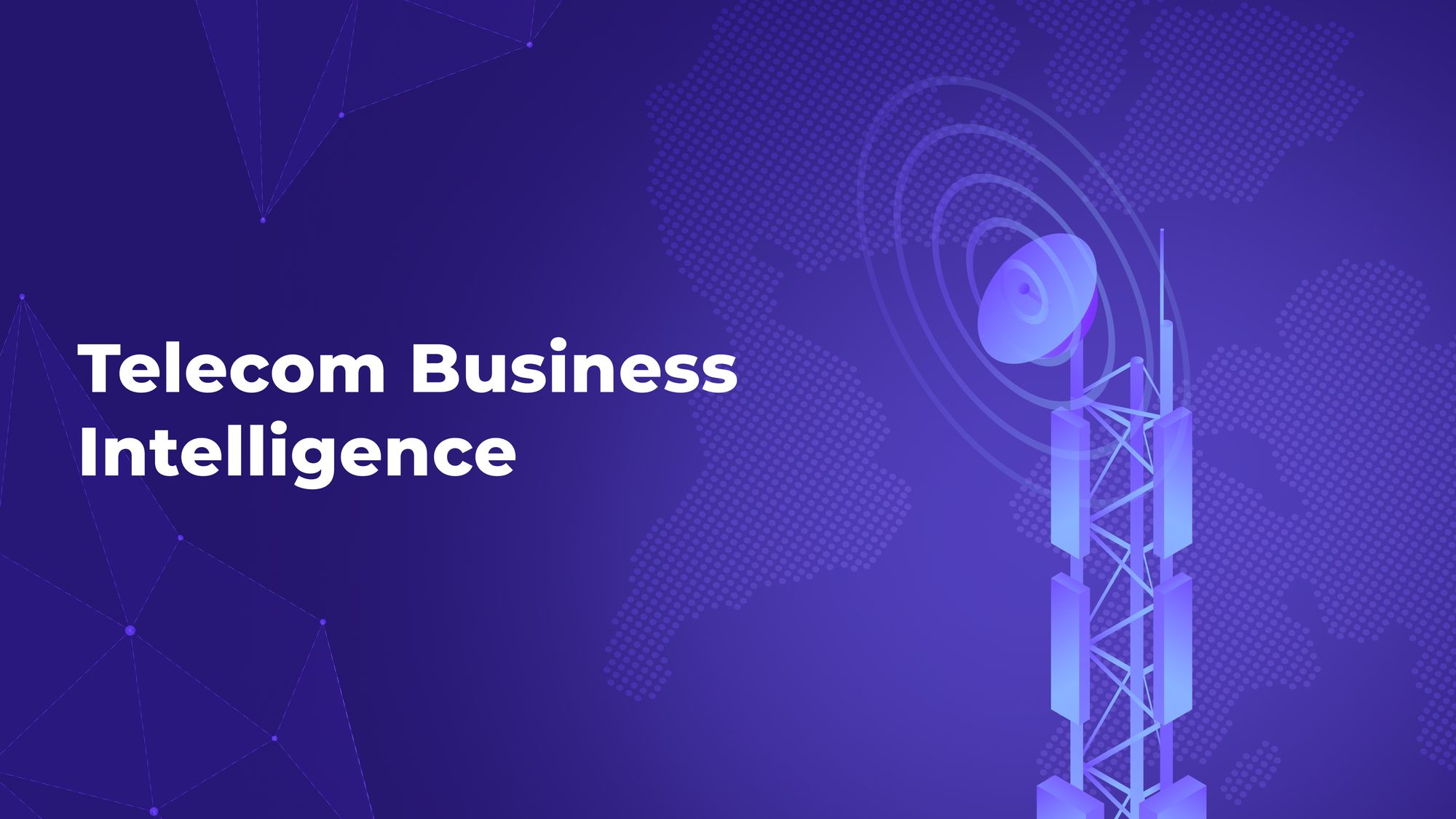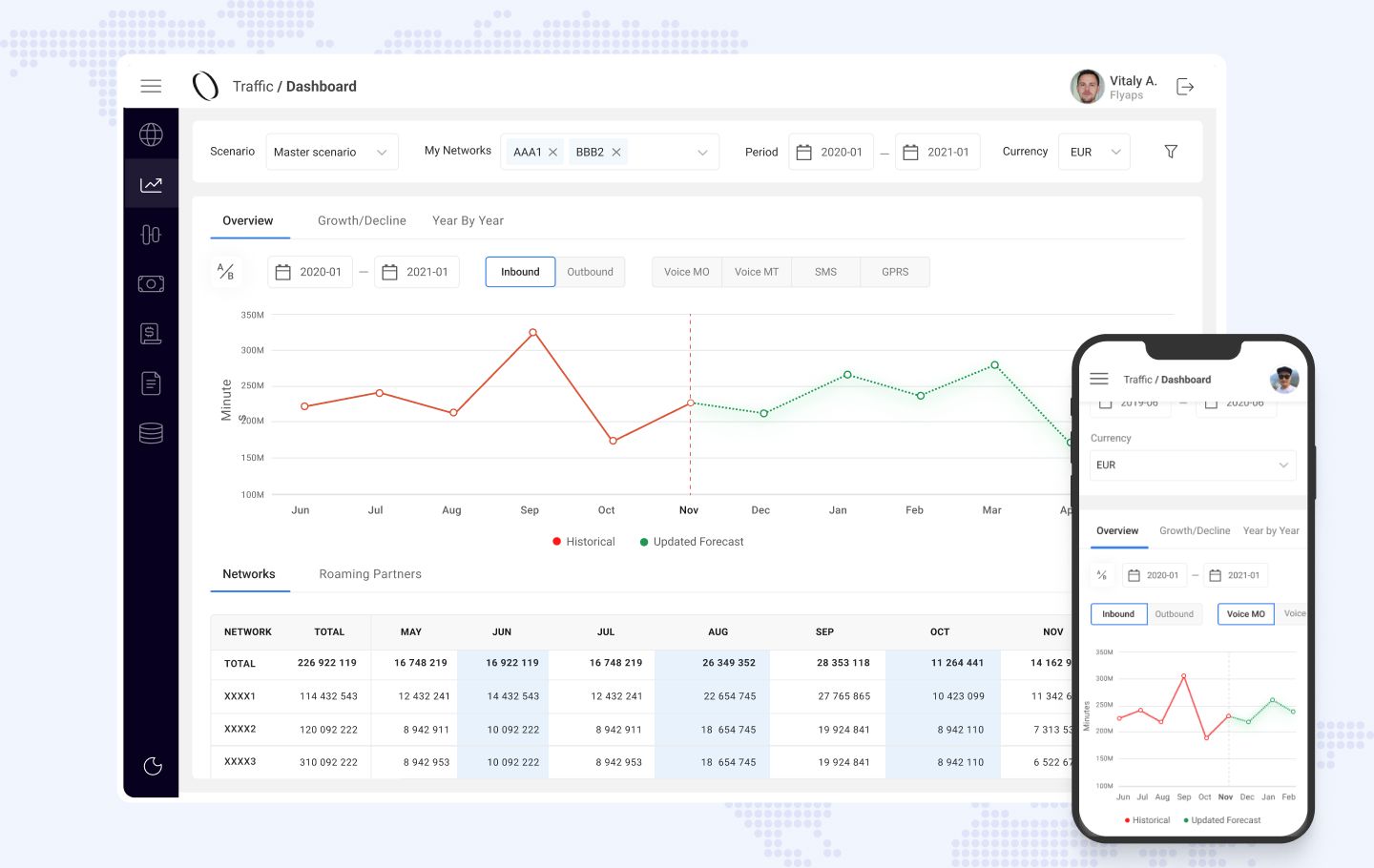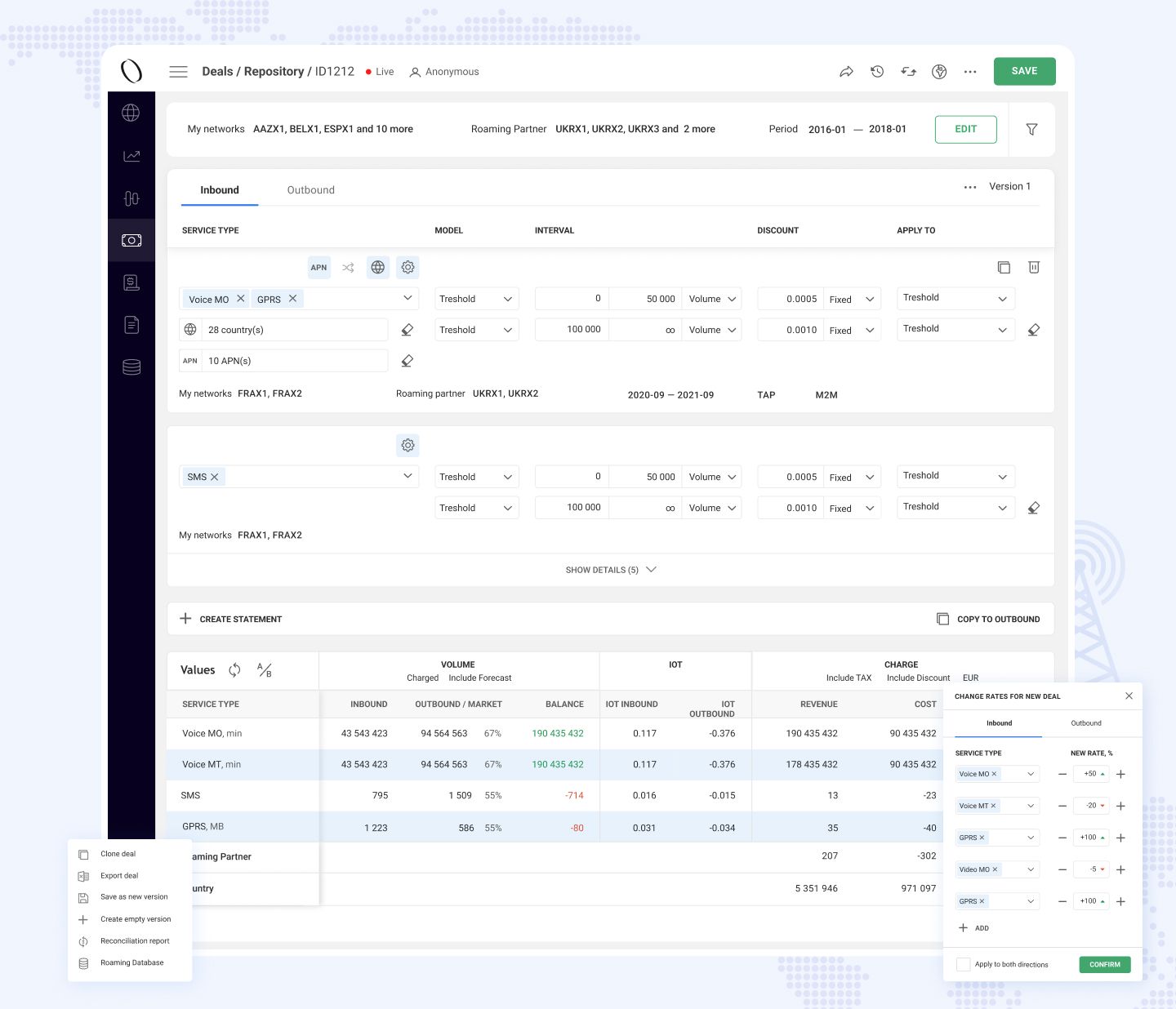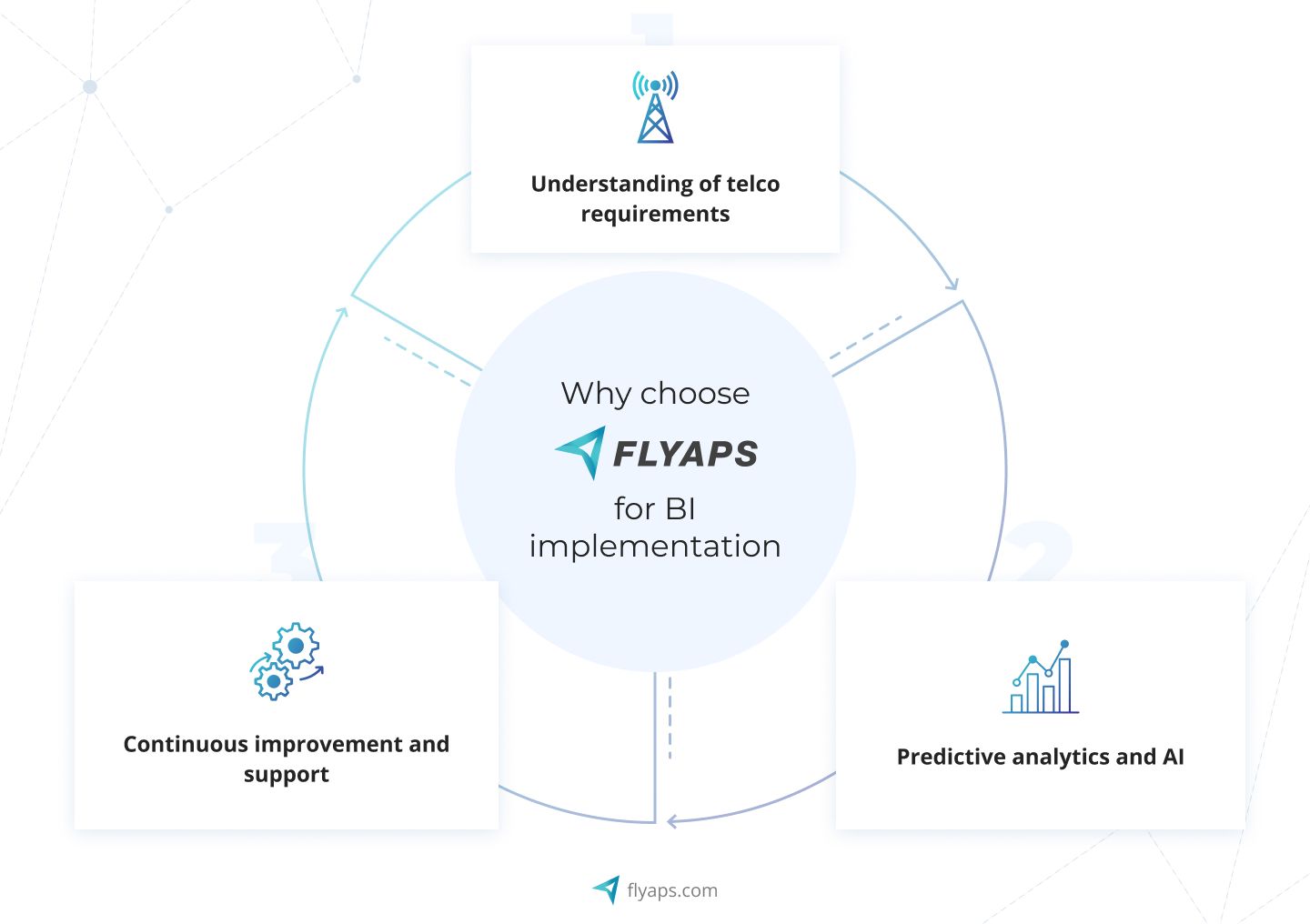Telecom Business Intelligence: The Future of BI in the Telecom Industry

Even though the industry is advancing at a rapid pace, many telecommunication companies find it hard to scale their digital operations successfully. According to Gartner, by 2025, approximately 80% of organizations striving to expand their digital business ventures will encounter failure due to a lack of adopting a modern approach to data and analytics governance.
These statistics highlight how crucial business intelligence is for telecommunications. Implementing a robust business intelligence strategy enables telcos to effectively manage and govern their data assets, ensuring that accurate, reliable, and timely information is available for decision-making.
At Flyaps, we have more than a decade of hands-on experience in the telco industry. We know the struggles telcos face in handling their data. From our perspective, when you have the right expertise and powerful telecom business intelligence solutions in place, amazing things can happen. It can empower you to become truly data-driven and empower transformations within your business operations.
Based on our expertise in software development and deep understanding of the telecom industry, we would like to offer some insights into how telcos can effectively implement business intelligence solutions and what they should expect. Keep reading to learn what telecom business intelligence trends you should take into account in 2023 and explore a few success stories of business intelligence implementations.
Why is business intelligence (BI) so crucial for telecom these days?
To better understand why there is so much buzz around business intelligence in telecommunications, let's take a look at how it works in real life. Imagine a telecommunications company that wants to enhance its decision-making and operational efficiency. To achieve this, they decided to utilize a telecom business intelligence tool.
The first step for the company is to collect a vast amount of data from various sources and store it in a data warehouse. This warehouse serves as a centralized repository that brings together data from multiple sources. They gather information on customer behaviour, for example, which services customers use the most and how frequently they make calls or browse the internet. They also collect call records to understand the number of calls, their duration, and the locations involved. Additionally, they gather network performance metrics to monitor the quality of their network and identify areas that require improvement. They also collect billing information to analyze revenue and expenses.
Once all this data is collected, the company employs an advanced BI tool to analyze it. The business intelligence software starts by querying the data warehouse. It then presents the results to the user in the form of reports, charts, graphs, and dashboards. This interactive visual data representation makes it easy for decision-makers to comprehend the information and identify crucial areas for improvement. For instance, a dashboard can provide real-time network performance metrics and send alerts to users when certain thresholds are exceeded.

Lastly, with a telecom business intelligence system in place, the company can identify network usage patterns, trends, and correlations within the data. For example, they might discover that customers who use a particular service tend to have longer call durations or that network performance issues occur more frequently during peak hours. These actionable insights empower the company to make well-informed decisions regarding service enhancements, network upgrades, and pricing strategies.
For modern telcos business intelligence is crucial for several reasons:
Improved business decisions
Implementing business intelligence tools empowers telecom operators to make timely and well-informed decisions based on concrete evidence, resulting in improved business performance and gaining a competitive edge.
Let’s say a telco notices a decline in revenue from a particular service package offered to residential customers. Using their business intelligence tools, they perform data analysis and discover that customers in urban areas have been opting for a competitor's service due to their attractive pricing. Armed with this evidence-based insight, the company can make informed business decisions and reduce customer churn. For example, they may decide to adjust the pricing strategy to offer competitive rates that align with customer expectations.
As a result, the company experiences an increase in customer acquisition and a revenue increase from the previously declining service package. They might also continue to monitor the performance of this service, using business intelligence to track customer response and fine-tune their offerings.
In this case, BI tools enable the telco to access comprehensive data, identify trends, and make strategic decisions. By leveraging telecom business intelligence, companies can better respond to market changes, optimize its offerings, and drive positive business outcomes.
From cloud migration to telecom-specific AI solutions, we have delivered over 20 projects that are used by hundreds of MNOs and telecom companies worldwide. Check our capabilities and let’s discuss your next solution.
See our servicesEnhanced operational efficiency
BI solutions help optimize various aspects of operations. For instance, a telco can use BI tools to identify which services customers use the most, and focus on improving those specific offerings.
Higher level of customer satisfaction
BI enables telcos to understand individual customer preferences, usage patterns, and needs. By providing a personalized digital customer experience, telecom companies can improve customer loyalty and retention.
For example, through BI analysis, telcos can identify that a particular group of customers prefers data-heavy plans for streaming and online gaming. As an outcome, they can offer specialized data packages catering to this specific target group, ensuring a personalized experience that meets their customers' preferences.
Furthermore, by understanding customer usage patterns, telcos can proactively offer customized recommendations or targeted promotions based on individual usage behaviors. This personalization enhances customer satisfaction and leads to better customer relations.
Cost optimization
BI enables telcos to identify cost-saving opportunities and optimize resource allocation. For example, through BI analysis, telcos can identify that a significant part of their network resources is underutilized during certain hours of the day. With this insight, they can allocate resources and adjust their network capacity to match the demand more efficiently. By optimizing resource allocation, they can reduce unnecessary costs associated with overprovisioning and maximize the utilization of their network infrastructure.
Additionally, BI tools help telcos analyze their operational expenses and identify areas where cost-saving measures can be implemented. They can examine data related to vendor contracts, procurement, and operational processes to identify opportunities for negotiation, consolidation, or streamlining. By leveraging these insights, telcos can make informed decisions related to cost optimization without compromising the quality of their services.
Telecom business intelligence trends for 2023
When it comes to business intelligence in the telecommunication industry, we can highlight five important trends for you to follow. These trends include predictive analytics, composable analytics, AI-based business analytics, data visualization, and cloud-based analytics solutions.

Predictive analytics
Predictive analytics is a trend in telecom business intelligence that focuses on predicting future business outcomes. This type of analytics uses historical data and estimated future data to forecast probabilities. While it's not perfect and can have some errors, the accuracy continues to improve as technology advances and evolves.
In the telecommunication industry, predictive analytics is used in various ways. For example, telcos can use predictive analytics tools to anticipate customer churn, when customers are likely to switch to a different provider. By analyzing past customer behavior and behavioral patterns, a telecom company can identify factors that contribute to customer churn, such as, for instance, poor network quality. It can also be used to forecast network capacity requirements, optimize resource allocation, predict customer demand for new services, and even anticipate technical failures or outages.
Composable analytics
As more organizations use advanced analytics tools to drive better decision-making, there's a need to provide access to these tools to all departments, even those without tech specialists. The idea here is to create a system where everyone in the organization can use analytics tools on their own, without needing extra help. That is where composable analytics come in handy.
Here's an example for better understanding. Let's say a telecom company wants to enhance its business intelligence capabilities to improve decision-making across various departments. They have customer service teams, marketing teams, and network operations teams, each with their specific data needs and analytical requirements.
Each department would use separate data analytics tools, resulting in fragmented data analysis and limited collaboration efforts. However, realizing the importance of a unified view of data, the company decides to adopt composable analytics.
With composable analytics, the telecom company integrates multiple analytics solutions into a cohesive system. They combine the data visualization capabilities of one tool, the predictive analytics features of another, and the reporting functionalities of yet another tool. By doing so, they create a custom business application that provides a comprehensive view of their data.
Now, each department can access this unified analytics platform, regardless of their technical expertise. Customer service representatives can track customer satisfaction metrics in real-time, marketing teams can identify target segments based on predictive models, and network operations teams can track network performance and identify potential issues proactively.
By leveraging composable analytics, the telecom company avoids duplicating data and using additional resources, which leads to improved cost management. The company no longer needs to invest in multiple standalone tools for each department, reducing expenses and increasing efficiency.
As a result, the company gains valuable insights across all business units. They can identify emerging trends in customer behavior, optimize marketing campaigns, and proactively address network performance issues. This not only helps the telecom business make better-informed decisions but also enhances their overall competitiveness in the telecom industry.
AI-based business analytics
Traditionally, businesses used to rely on reports that were based on historical data and events that already happened. But now, with AI-driven analytics, telcos can have real-time dashboards and alerts that keep them updated on what's happening right now and how it might affect future operations. This is all thanks to AI algorithms that use advanced neural networks. Those networks recognize patterns in the historical data, so if something unexpected or unusual occurs, the AI can quickly identify it and notify users.
AI also makes analysis easier and faster. Instead of spending time manually going through data, AI algorithms can automatically analyze the data businesses choose, like revenue numbers. They can unveil hidden insights on growth, trends, forecasts, and more. To take full advantage of such technologies, it’s important to follow proven AI implementation strategies that ensure scalable and efficient adoption. To build and scale such capabilities, telcos often rely on modern AI development platforms that provide the infrastructure and tools necessary for creating, training, and deploying AI-driven solutions (learn more about the cost of building AI in 2025).
One big challenge for telecom organizations is dealing with unstructured data. This means information that doesn't have a specific structure or format. Think of things like text, images, videos, social media posts, emails, or PDF documents. They don't fit neatly into tables and columns like structured data does. As an outcome, this type of data is harder to organize and analyze. But thanks to AI and machine learning, organizations can now analyze unstructured data more easily.
Data visualization
Instead of looking at raw data and numbers, with data visualization tools you can create charts, graphs, and other visual elements to explore and analyze data hassle-free.
For example, a roaming provider can use modern telecom business intelligence tools to transform their data into visually appealing charts, graphs, and interactive dashboards. What’s more, with a custom system, you can create dashboards that show the distribution of customer satisfaction ratings, call wait times, and network performance metrics over time. With these visual representations, your management team can quickly identify patterns and trends that were not clearly visible in the raw data alone.
Data automation
Data automation in the telecom industry involves using tools and technologies like AI, robotic process automation (RPA), and low-code business process automation to streamline various data-related processes. This trend aims to consolidate data from different sources and provide methods to discover, analyze, measure, monitor, and evaluate large-scale data more efficiently.
One specific area where data automation is utilized is intelligent reporting. Let’s say a telco implemented predictive analytics models that analyze historical user data to forecast future customer behavior. With data automation, business users within the company’s marketing team can quickly access a user-friendly dashboard that automatically generates reports based on these predictive models.
Previously, generating such reports required the involvement of an IT department and manual data analysis. Now, thanks to data automation, business users can easily get automated reports, eliminating the need to rely on the IT department for data analysis tasks. This empowers the marketing team to make data-driven decisions independently, such as identifying target customer segments, optimizing marketing campaigns, and improving customer experience.
Use cases of telecom business intelligence
In the world of business intelligence, there are many tools available for collecting and analyzing data. You might even think that something as basic as an Excel spreadsheet might do the job. However, when it comes to the telecommunications industry, it's a whole different story. Telecom businesses require custom tools that are tailored to their specific needs. Many of these advanced tools now incorporate AI technologies to unlock deeper insights and drive smarter decisions. For a broader look at how generative AI is transforming industries explore our article on Generative AI use cases. Let's delve into some use cases of business intelligence in the telecom industry for better understanding.
Telecom business intelligence tool for analytics in roaming and forecasting
NeuString Analytics, a leader in predictive analytics for mobile telecommunications and a part of Yaana Technologies, faced a challenge with their outdated desktop system. The application was used by NeuString Analytics clients for analytics in roaming, managing discount agreements, negotiating with roaming partners, and forecasting. Recognizing the limitations of the desktop platform, the company wanted a more advanced and user-centered solution to serve their clients needs better. That’s why they turned to Flyaps for help.
For NeuString Analytics, we developed a new web cloud-based application. Our goal was to update the existing features and add new ones to meet the changing clients needs. Despite having a tight schedule, we promised to deliver the first version within four months and we successfully managed the task!

We migrated essential functionalities from the legacy system to the cloud. Users can now enjoy familiar services while benefiting from a more advanced platform. Additionally, we introduced new calculation and forecasting models, empowering users with comprehensive budgeting features. They can create multiple budgets, compare them, and gain a broader perspective for planning.
We seamlessly integrated our cloud-based solution with the legacy system, exporting the database for reporting and presenting it on dynamic dashboards, including an interactive world map. These dashboards can display volume, charges, and insights categorized by country, period, service types.
We carefully designed a user-friendly interface, investing time and effort into the ease of uses while maintaining visual appeal. Using the UI guidelines, we ensured consistency across the system.

As a result, NeuString Analytics clients now have a highly performative one-of-a-kind system. Even such giants as Orange Group and Hutchison 3G UK Ltd find the solution indispensable for forecasting, negotiation, budgeting, and data analysis.
How Flyaps can help you with BI implementation

Understanding of telco requirements: With over 10 years of experience in the telecommunications industry, we have a proven track record of developing products that are actively used by over 100 telecom companies, including renowned corporations like Orange Group. Our extensive expertise has given us a deep understanding of the unique challenges and requirements within the telecom sector.
Drawing on our experience in telecom, we know the specific demands, obstacles, and objectives telcos face when it comes to implementing BI solutions. In close collaboration with us, you can identify the crucial key performance indicators (KPIs) and data sources essential for effective BI implementation.
Predictive analytics and AI: At Flyaps, we employ machine learning algorithms to develop predictive models for churn analysis, customer segmentation, demand forecasting, fraud detection, and other relevant use cases. These predictive insights help telcos proactively address challenges and make data-driven decisions.
Continuous improvement and support: BI implementation is an ongoing process that requires continuous improvement and maintenance. Flyaps can offer ongoing support, monitoring, and maintenance services to ensure your BI solution remains efficient and up-to-date. We can perform periodic system upgrades and incorporate new data sources or analytics capabilities as your business scales.
Supercharge your telecom business with our expert business intelligence services. Get in touch now.








